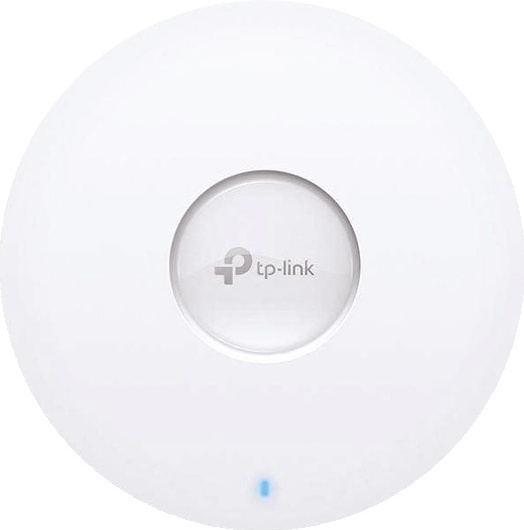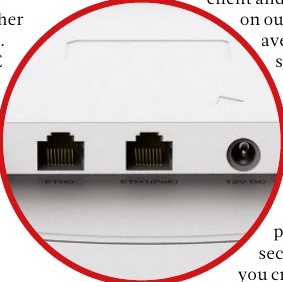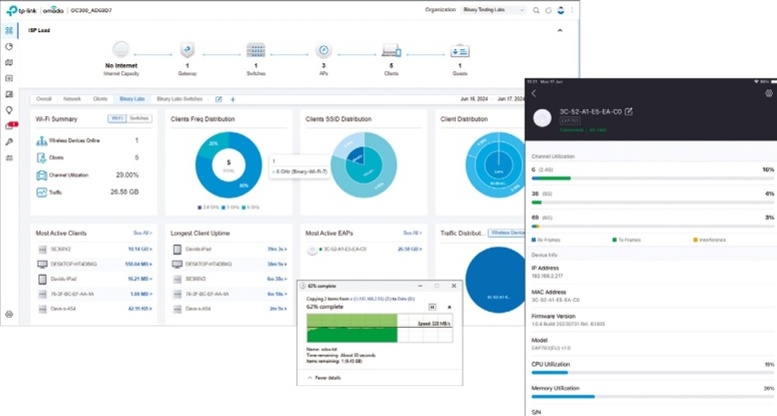
This review first appeared in issue 360 of PC Pro.
TP-Link’s first Wi-Fi 7 business access point (AP) sets a high standard for the rest to follow, as this slimline discus has a mighty BE19000 rating. The EAP783 achieves this with a claimed 1,376Mbits/sec on the 2.4GHz radio, 5,760Mbits/sec on 5GHz and a speedy 11,520Mbits/sec on 6GHz, with the latter enabling the ultrawide Wi-Fi 7 320MHz channels.
It’s also one of the first APs to support the multi-link operation (MLO) feature, which allows devices to connect to the 2.4GHz, 5GHz and 6GHz bands simultaneously for increased throughput and reduced latency. The only downside is that very few end-user devices currently support MLO, and Windows users will have to wait until Windows 11 24H2 is fully released.
The EAP783 has other appealing credentials. It provides two 10GbE ports, with the first requiring an 802.3bt PoE++ power source; there’s also an input for TP-Link’s optional 12V adapter. The second 10GbE port is designed to be aggregated with the primary network port for a higher network connection speed.
Despite the AP’s 12 internal aerials, TP-Link has kept the size down to a manageable 280mm diameter and a thickness of 47mm. It’s heavy, though, tipping the scales at 1.4kg – around 15g more than Zyxel’s WBE660S.

The EAP783 supports standalone mode, where the web console’s quick start wizard requests a new username and password, after which it removes the default admin account for extra security. Eight SSIDs per radio can be created, and the wizard asks you to configure the first three and provide new encryption keys.
For our real-world Wi-Fi 7 performance tests we connected the AP to the lab’s Zyxel XS1930-12HP 10GbE PoE++ switch and used a Lenovo desktop client running Windows 11 Pro 24H2 Insider Preview and fitted with a TP-Link Archer TBE550S Wi-Fi 7 PCI-E adapter. With Windows reporting a Wi-Fi 7 connection speed of 5,764Mbits/sec, we saw large file copies between the client and a Windows server on our 10GbE LAN averaging close-range speeds of 323MB/sec, dropping to an equally impressive 280MB/sec with the AP placed ten meters away in an adjoining room.
The web console provides a separate section for MLO where you create a new SSID and decide which of the three radios to assign to it. Performance-wise, we saw no benefits from a triple radio MLO SSID as the Windows 11 client reported the same speed as a standard Wi-Fi 7 connection and our copies were no faster.
TP-Link offers plenty of cloud management choices. You can deploy its hardware or free software controller on-site or use its cloud-hosted controller, which has a yearly fee of £165 for 250 devices. We use TP-Link’s OC300 dual-port controller appliance in the lab as its £130 price enables lifetime cloud management of up to 500 Omada APs, switches and routers.

All controllers are viewed from the Omada portal home page, and selecting the OC300 transported us to its own console. This presents a ribbon across the top showing all cloud-managed devices, and selecting a site below provides options to create multiple dashboards with a wide range of widgets.
The EAP783 initially appears as “pending” in the portal, and all you do is adopt it and assign it to a site. It only takes a minute, after which the AP disables its local web interface for security reasons, takes all its settings from the controller and broadcasts your preconfigured SSIDs.
It’s easy to add more SSIDs, apply a desired personal or enterprise encryption scheme, set client and SSID rate limits and define schedules to determine when they’re active. For the EAP783, we could enable any of all of its three radios, and we noted the portal has an option to create MLO Wi-Fi 7 SSIDs.
The EAP783 will appeal to businesses looking to make an early transition to Wi-Fi 7. It delivers excellent performance and is MLO-ready, and TP-Link’s Omada cloud platform offers great remote management services.







